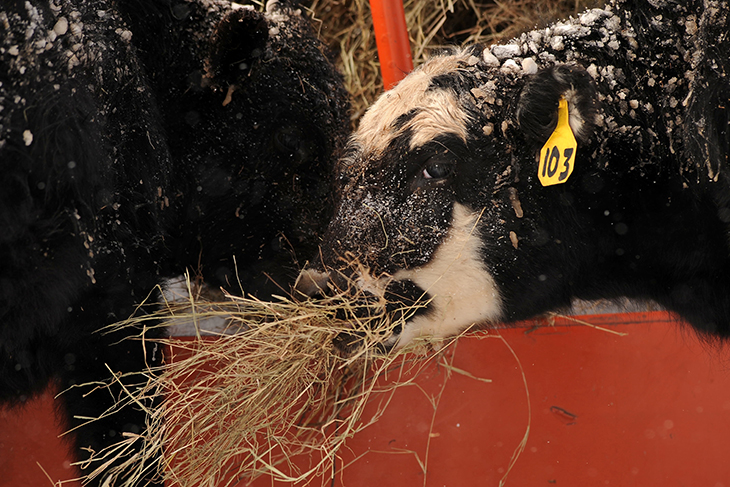Source: Oklahoma State University

Several Oklahoma counties have experienced snowfall already, heralding the start of hay feeding season that will expand to other counties in the coming weeks, and the need for producers to employ some value-adding mathematics.
“Estimating forage usage by cows is an important part of the task of calculating winter feed needs,” said Glenn Selk, Oklahoma State University Cooperative Extension emeritus animal scientist and managing editor of the university’s popular OSU Cow-Calf Corner newsletter.
Hay or standing forage intake must be estimated in order to make the calculations. Forage quality will be a determining factor in the amount of forage consumed.
“Higher-quality forages contain larger concentrations of important nutrients, so animals consuming these forages should be more likely to meet their nutrient needs from the forages,” Selk said. “Also, cows can consume a larger quantity of higher-quality forages.”
Higher-quality forages are fermented more rapidly in a cow’s rumen, leaving a void the animal can refill with additional forage. Consequently, forage intake increases.
For example, low-quality forages, those below about 6 percent crude protein, will be consumed at about 1.5 percent of body weight on a dry matter basis per day. Higher-quality grass hays, those containing more than 8 percent crude protein, may be consumed at about 2 percent of body weight on a dry matter basis per day. Excellent forages, such as good alfalfa, silages or green pasture, may be consumed at the rate of 2.5 percent of body weight on a dry matter basis per day.
“The combination of increased nutrient content and increased forage intake makes high-quality forage very valuable to the animal and the producer,” Selk said. “Using these intake estimates, producers can calculate the estimated amounts of hay that need to be available for their specific operations.”
As an example, assume 1,200-pound pregnant spring-calving cows foraging on grass hay of good quality that has tested to have 8 percent crude protein. Cows can be expected to voluntarily consume 2 percent of their body weight or 24 pounds per day.
“The 24 pounds is based on 100 percent dry matter,” Selk said. “Grass hays often will be 7 percent to 10 percent moisture. If we assume the hay is 92 percent dry matter, then the cows will consume about 26 pounds per day on an as-fed basis.”
However, producers also need to consider hay wastage when feeding big round bales. Hay wastage is difficult to estimate, but studies show it generally will be from 6 percent to 20 percent, and sometimes more.
“Using the example above, let’s assume 15 percent hay wastage,” Selk said. “This means approximately 30 pounds of grass hay must be hauled to the pasture for each cow, each day the hay is expected to be the primary ingredient in the animal’s diet.”
After calving and during early lactation, the cow may weigh 100 pounds less, but will be able to consume about 2.6 percent of her body weight on a dry matter basis in hay. This would translate into 36 pounds of as-fed hay per cow per day when determining how much hay must be hauled to the pasture, again assuming 15 percent hay wastage.
“Accurate knowledge of average cow size in a producer’s specific herd as well as the average weight of available big round bales becomes necessary to predict hay needs and hay feeding strategies,” Selk said.
It is important to remember big round hay bales will vary in weight. Diameter and length of the bale, density of the bale, the type of hay and moisture content will greatly influence weight of the bale. One of the most easily doable methods of estimating bale weights is to weigh a pickup or trailer with and without a bale.
“Utilizing standing forage in native and bermudagrass pastures to supply much of the forage needs during fall and early winter months will reduce hay feeding,” Selk said. “An appropriate supplementation program will help the cows digest the lower-quality roughage in standing forage.”
When standing forage is in short supply or covered by snow and ice, hay will become the primary source of feed. The number of days hay feeding will be necessary is hard to predict going into the winter months. Looking back at previous years’ records may be the best source of information to help make that determination.
Oklahoma is the nation’s second-leading producer of beef cows and third-leading producer of calves, according to USDA National Agricultural Statistics Service data.
The Oklahoma Cooperative Extension Service is one of two state agencies administered by OSU’s Division of Agricultural Sciences and Natural Resources, and is a key part of the university’s state and federally mandated teaching, research and Extension land-grant mission.
PO BOX 101988
FORT WORTH, TX 76185
1-800-242-7820
© 2023 Texas & Southwestern Cattle Raisers Association; All Rights Reserved.
